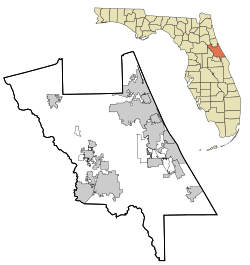Volusia, Florida
|
Volusia Maiaca Volusia Landing |
|
|---|---|
| Unincorporated community | |

Historic oak near the St. Johns River
|
|
| Nickname(s): "Town of Many Forts" | |
| Coordinates: 29°10′07″N 081°31′15″W / 29.16861°N 81.52083°WCoordinates: 29°10′07″N 081°31′15″W / 29.16861°N 81.52083°W | |
| Country |
|
| State |
|
| County | Volusia |
| Settled | Before 1558 |
| Area | |
| • Total | 1.8 sq mi (5 km2) |
| Elevation | 16 ft (5 m) |
| Population (2010) Estimated by adding count in all census blocks overlapping area of Volusia | |
| • Total | 596 (estimate) |
| Demonym(s) | Volusian |
| Time zone | Eastern (EST) (UTC-5) |
| • Summer (DST) | EDT (UTC-4) |
| enter ZIP code | 32102 |
| Area code(s) | 352 |
| GNIS feature ID | 306545 |
Volusia (/vəˈluːʃə/, və-LOOSH-ə) is an unincorporated community in Volusia County, Florida, United States on the eastern shore of the St. Johns River, about three miles south of Lake George and across the river from the town of Astor in Lake County. Volusia is one of the oldest European settlements in Florida. The main route through the town is State Road 40, which crosses the St. Johns on the Astor Bridge.
Volusia County takes its name from the community of Volusia, which was named such by at least as early as 1815. The site of Volusia was an established native settlement by 1558 when its indigenous inhabitants, the Mayaca, were first encountered by Spanish explorers. Since then, it has been the location of several forts, trading posts and a port on the St. Johns River, as well as the site of conflicts with the Seminole people during Florida's tumultuous beginnings.
The indigenous Mayaca people inhabited much of the area now known as Volusia County along the St. Johns river. A settlement just south of Lake George known Maiaca (or Mayaca) was likely the largest of the Mayaca villages. Historical sources frequently refer to the native Timucua as having inhabited large areas of Florida including areas along the St. Johns river. However, other sources posit that the Mayaca were a distinct group of people with their own language, customs and settlements. Alliances were formed between smaller native groups. The village of Mayaca (Mayarca) was identified as belonging to the Outina confederation at one point, and with the Saltwater Timucua at another.
...
Wikipedia

